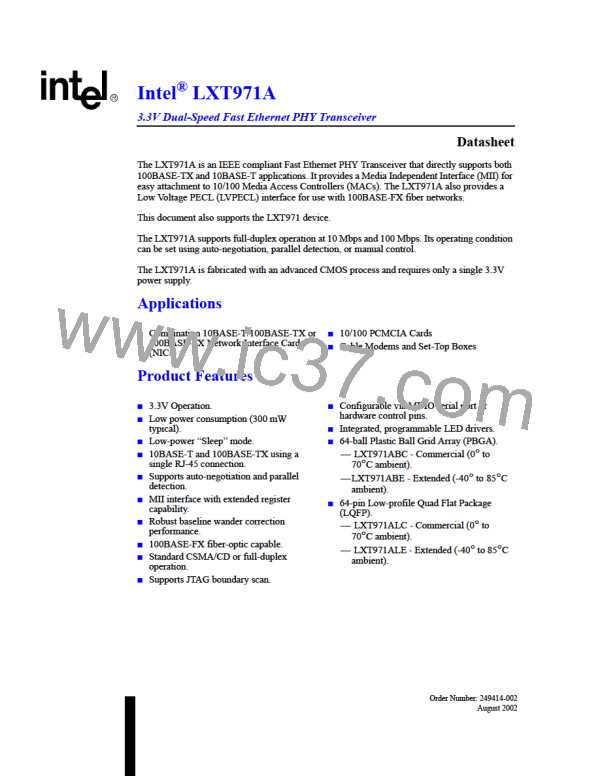LXT971A 3.3V Dual-Speed Fast Ethernet Transceiver
Table 11. 4B/5B Coding
4B Code
5B Code
4 3 2 1 0
Code Type
Name
Interpretation
3 2 1 0
0 0 0 0
0 0 0 1
0 0 1 0
0 0 1 1
0 1 0 0
0 1 0 1
0 1 1 0
0 1 1 1
1 0 0 0
1 0 0 1
1 0 1 0
1 0 1 1
1 1 0 0
1 1 0 1
1 1 1 0
1 1 1 1
undefined
0
1
1 1 1 1 0
0 1 0 0 1
1 0 1 0 0
1 0 1 0 1
0 1 0 1 0
0 1 0 1 1
0 1 1 1 0
0 1 1 1 1
1 0 0 1 0
1 0 0 1 1
1 0 1 1 0
1 0 1 1 1
1 1 0 1 0
1 1 0 1 1
1 1 1 0 0
1 1 1 0 1
1 1 1 11
Data 0
Data 1
2
Data 2
3
Data 3
4
Data 4
5
Data 5
6
Data 6
7
Data 7
DATA
8
Data 8
9
Data 9
A
B
C
D
E
F
I 1
Data A
Data B
Data C
Data D
Data E
Data F
IDLE
Used as inter-stream fill code
Start-of-Stream Delimiter (SSD),
part 1 of 2
0 1 0 1
0 1 0 1
J 2
K 2
T 3
R 3
1 1 0 0 0
1 0 0 0 1
0 1 1 0 1
0 0 1 1 1
Start-of-Stream Delimiter (SSD),
part 2 of 2
CONTROL
End-of-Stream Delimiter (ESD),
part 1 of 2
undefined
undefined
End-of-Stream Delimiter (ESD),
part 2 of 2
1. The /I/ (Idle) code group is sent continuously between frames.
2. The /J/ and /K/ (SSD) code groups are always sent in pairs; /K/ follows /J/.
3. The /T/ and /R/ (ESD) code groups are always sent in pairs; /R/ follows /T/.
4. An /H/ (Error) code group is used to signal an error condition.
40
Datasheet
Document #: 249414
Revision #: 002
Rev. Date: August 7, 2002

 INTEL [ INTEL ]
INTEL [ INTEL ]